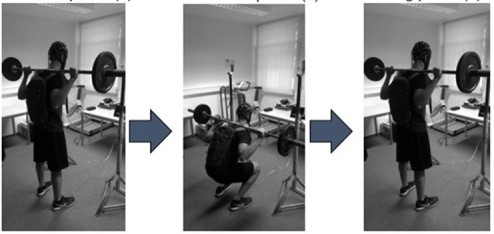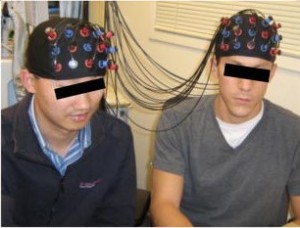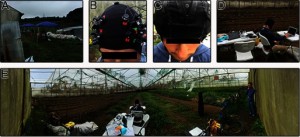[last update: 2019-02-20]
Let’s be frank. Compared to fMRI, NIRS has a number of intrinsic weaknesses. The signal to noise ratio is lower, the spatial resolution is (10x) lower, it can’t measure the deep brain, and it only covers a portion of the brain surface. As a result, fMRI, when possible, is still the preferred method to elucidate brain mechanisms. So if we do use NIRS, we’d better do experiments fMRI can’t, or at least very difficult to, do.
Below are 6 experiments NIRS can do, but fMRI can’t (or difficult to do):
- Study of the mechanism of BOLD signal
- Study of the relationship between oxygenated and deoxygenated hemoglobin concentration
For a given voxel, fMRI only gives you a single number at a time. The number (BOLD signal) depends on many factors. On the other hand, NIRS can give you two numbers, the concentrations of both oxygenated and deoxygenated hemoglobin. So if you ever want to study the relationship between them, we should use NIRS. For an example, please check out https://www.ncbi.nlm.nih.gov/pubmed/19945536 - Study of the fine temporal change of BOLD signal
In most fMRI settings the temporal resolution of BOLD signal is low (about 2 seconds, or 0.5Hz). That means we only get a number every two seconds. If we want to know the rise and fall of the BOLD signal in much higher temporal resolution, e.g. 10Hz, then NIRS would be a good choice.
- Study of the relationship between oxygenated and deoxygenated hemoglobin concentration
- Study in naturalistic settings
If you ever participate in a fMRI study, you will feel the room far from friendly. The scanner is loud, and it looks scary. During the entire experiment, you are lonely inside the confined space. You can’t move, can’t talk (for most experiments), and feel guilty when you swallow saliva as the experimenter probably told you in advance that any motion might distort the signal. What you often see is much simple visuals (such as blocks and circles) on a computer screen. Do we live such a life in reality? On the contrary, NIRS is small, even portable, and can be used in a naturalistic environment.- Sports and exercise
As long as the optodes are attached to the head nicely to ensure proper signal collection, the participants can move freely. NIRS has been used in a number of sports or exercises studies such as running, squatting, biking, ping-pong, piano playing, and stretching etc. Be sure to check out the videos in https://www.ncbi.nlm.nih.gov/pmc/articles/PMC5434677/

Source: https://www.ncbi.nlm.nih.gov/pmc/articles/PMC5430058/ - Face to face communication
You might see other people’s face on a screen in fMRI, but with NIRS, you can see a real face. We humans are fundamentally social, and to study social behavior in a naturalistic environment is important. NIRS allows you to study face-to-face gaming (video or board), talking, brain storming, cooperation or competition, etc. For example, in one of our studies (https://www.ncbi.nlm.nih.gov/pmc/articles/PMC3254802/) participants played a video game together. my colleague Ning Liu et al has an experiment when two people play Jenga games (https://www.ncbi.nlm.nih.gov/pmc/articles/PMC4782164/). - Study in a moving environment
Many NIRS devices are small enough so you can carry it in a car or even a backpack. That means you can study the driver’s brain when he is actually driving! An example would be https://www.ncbi.nlm.nih.gov/pmc/articles/PMC5671603/
- Sports and exercise
- Hyperscanning
fMRI can be used in hyperscanning studies, and in fact the first hyperscanning is done with fMRI by my former advisor Dr Montague (https://www.ncbi.nlm.nih.gov/pubmed/12202103). However, seeing it with first hand, I know hyperscanning with fMRI is technically challenging. You need two fMRI scanners, each costs a few million dollars; and you also need to synchronize them. On the other hand, many NIRS devices are able to do hyperscanning natually. For example, when we used ETG 4000, we simply use one patch on one participant and the other on another participant. It does not add complexity on the hardware part.
To date there are a number of hyperscanning studies with NIRS. For a list, please refer to https://www.ncbi.nlm.nih.gov/pubmed/?term=(fnirs+OR+nirs)+hyperscanning. If you are patient enough to scroll to the last page, you will find our paper!
- Real time (feedback), brain computer interface
Let’s say you want your participants to move a bar in a computer game mentally (brain computer interface), or you provide a real time neural feedback to your participants to improve cognitive function, in both cases you need the brain signal in real time. fMRI can do this too, but first you will need to get the data in real time, and second, due to poorer time resolution (2s), there will be some lag. Many NIRS devices allows you to get the measured signal out without delay, and of course the temporal resolution of NIRS is typically much higher (e.g. 10Hz). An recent example can be found at https://www.ncbi.nlm.nih.gov/pubmed/30634177
Some may argue that higher temporal resolution is not that useful because the BOLD signal is already slow (usually 4-6s from onset to peak). However, with finer temporal resolution, we can use algorithms (e.g. machine learning) to detect signal with much smaller delay. For example, in one of our studies the delay can be reduced by 50% (https://www.ncbi.nlm.nih.gov/pmc/articles/PMC2978722/) - Field studies, large scale studies
You can’t carry an fMRI scanner around for sure, but with NIRS’ portability, you can collect neural data in the field. My colleague Dr Baker took a NIRS device to the rural places in Costa Rica, and scanned the local farmers. Check out his paper.

In addition, since you may carry NIRS devices around, you can scan a lot of participants, e.g. a few hundred or even thousand. Imagine you are to study the brain and cognitive development of children in rural areas in China in a large scale (say 10,000 participants), then NIRS will become your top choice. - Study on special participants
Due to safety reason, the following people should not do fMRI experiments (source):- with shrapnel or other metal or electronic implants in their bodies (such as pacemakers, aneurysm clips, surgical devices, metallic tattoos on the head, etc.)
- pregnant
- with a history of head trauma or fainting
- currently using sleeping aids, painkillers (including aspirin), or other agents known to affect brain function (for instance, antihistamines, decongestants, etc.)
- with major medical, neurological, or psychological disorders (including depression, generalized anxiety, panic attacks, AD(H)D, strokes, tumors, heart conditions, claustrophobia, etc.)
In addition to this list, fMRI is also not friendly to infants (but still can be done in fMRI). In contrast, NIRS does not have issues with the participants in the list. Imagine you can do an experiment on claustrophobia with NIRS, but probably not with fMRI.



Hi Dr. Cui,
This was very helpful. I am sure someone will ask the same question in my defense (soon to come)! Thank you!